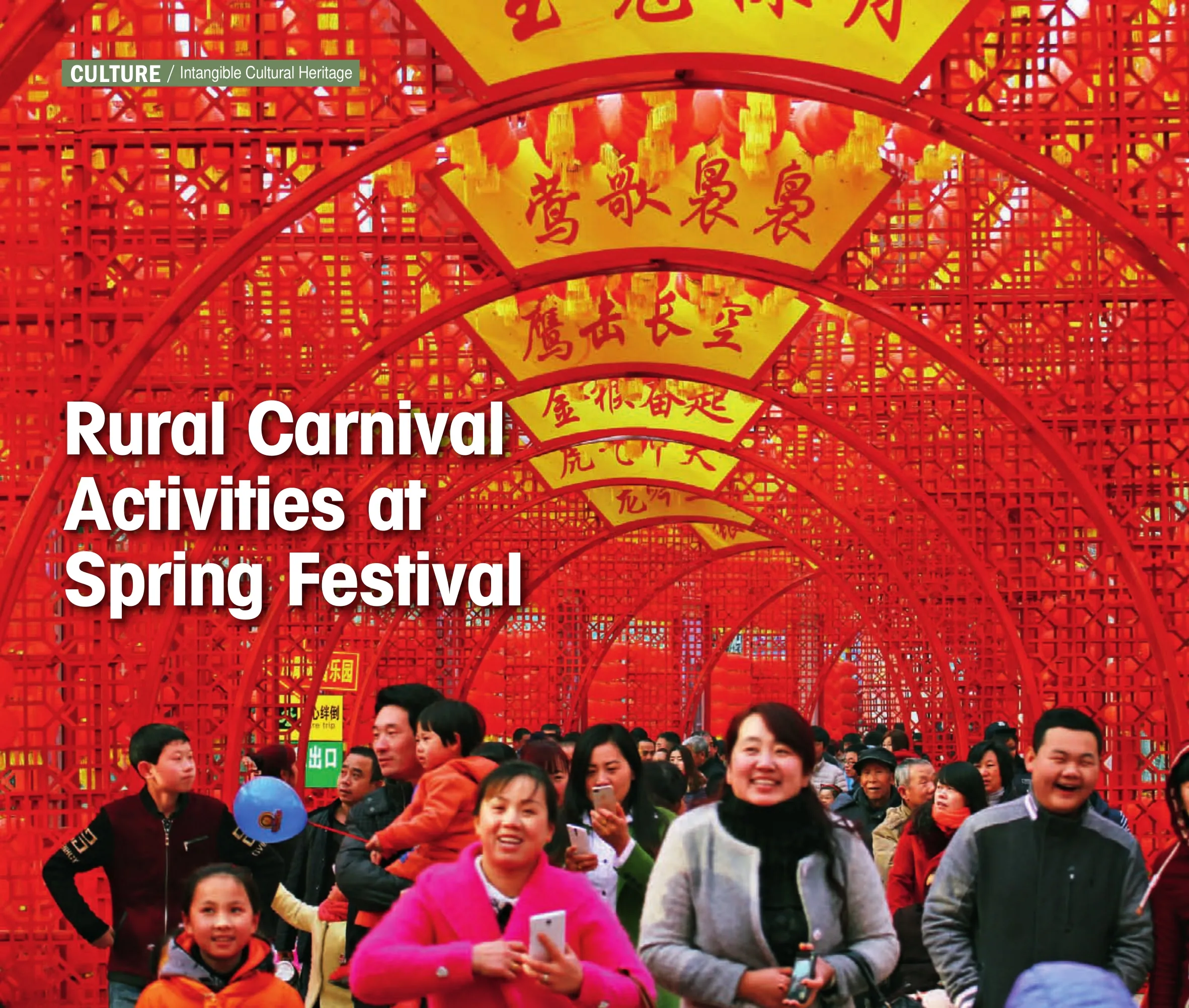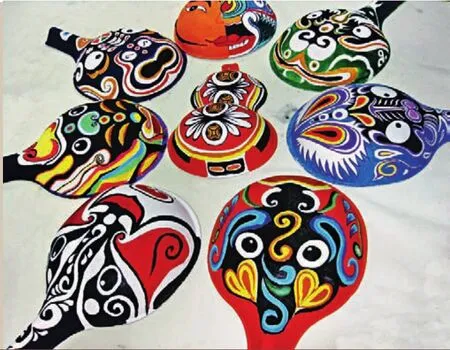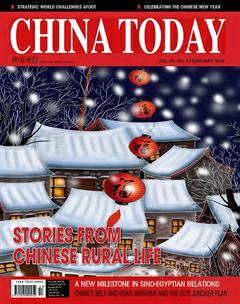rural Carnival activities at Spring festival
By staff reporter ZHANG LI
rural Carnival activities at Spring festival
By staff reporter ZHANG LI

Tourists at a temple fair last March in Taiyuan City enjoy a folk performance.
C HINA’S Spring Festival – a celebration of the lunar New Year – starts on the 23rd day of the 12th month of the agricultural calendar and finishes on the 15th day of the first month. Lunar New Year’s Eve and the first day of the New Year are its climax. China’s grandest and most important holiday, Spring Festival has for millennia been celebrated in diverse ways throughout the country.
Among the various stories about the origins of the Spring Festival the one most commonly accepted tells of how Emperor Shun, legendary leader of ancient China, inaugurated it more than 4,000 years ago on the day he succeeded to the throne and made obeisance to heaven and earth. People have since perceived that occasion as the first day of the New Year, and as how the Chinese lunar New Year came into being.
China’s grandest and most important holiday, Spring Festival has for millennia been celebrated in diverse ways throughout the country.
Winter is the slack season in China, historically an agricultural country. Having labored for a whole year, people take a rest at this time to prepare for the coming year. The coming New Year also signals the approach of spring, when grass and tree leaves start to sprout. The sacrifices that people offer to gods and ancestors are prayers for favorable weather, peace, and bumper harvests, and give Spring Festival its joyful ambience.
Offering sacrifice to the kitchen god on the 23rd of the 12th lunar month is the prologue to Spring Festival celebrations.
Folklore tells of the kitchen god that protects the hearth and family. Many households in rural China maintain the tradition of offering sacrifices to this domestic deity whose picture hangs on the wall. The kitchen god is believed to return to heaven on the 23rd day of the 12th lunar month to report to the Jade Emperor on the activities of each household over the past year. The Jade Emperor accordinglyeither rewards or punishes a family. That evening, food is offered and incense burnt before the kitchen god returns to heaven. Family members ply the kitchen deity with sticky malt sugar in hopes that it will sweeten what he has to say about the household, or that it will make his lips stick together, so making him incapable of badmouthing their household to the Jade Emperor. The couplets hanging on either side of the image of the kitchen god often say, “Report in sweet words after ascending to heaven; bring blessings and peace upon returning to the world.” Family members then kowtow to the god, and burn his picture, signifying that they have seen him off on his journey back to heaven. On the first day of the lunar New Year, they hang a new paper picture of the god on the wall to welcome him back.

After the 23rd, preparations for New Year celebrations get into full swing. These include cleaning the house from top to bottom, and shopping expeditions for food, gifts for family members, and new clothes for children. Nimble-fingered daughters make attractive papercuts to paste on the windows, and red lanterns are hung in front of the main door. Many families position the Chinese character fu, meaning fortune or good luck, upside-down on their front doors. As the words for “upside-down”and “to arrive” are homophonous in Chinese, an upside-down fu signifies the imminent arrival of good luck.

A performance of the lion dance on February 25, 2015, by residents of Bocheng Village in Neihuang County, Anyang City, Henan Province.

Residents of Ziyang Community in Hangzhou City gather on February 11, 2015, dressed in traditional costumes, for Lunar New Year dinner. The tradition of each household cooking its signature dish to share with neighbors on the 23rd of the 12th lunar month has been preserved in this old city district of Hangzhou.
Preparations are not complete until New Year’s Eve, when it is traditional to have a family reunion dinner.
These preparations are not complete until New Year’s Eve. It is traditional on that day to have a family reunion dinner. It is indeed the most important meal of the year. Dishes normally include chicken, because the first character of the Chinese phrase jixiang ruyi, which means “good fortune as one would wish,” is a homophone of ji meaning chicken. Fish is also included for similar reasons. The last character of the Chinese phrase niannian youyu, meaning “surpluses year after year,” means surplus, which is a homophone of the character yu that means fish. Dumplings are an essential com-ponent of New Year family dinners in north China. The entire household gathers together to make dumplings, chat and laugh. It is a labor of great joy for all concerned. While wrapping dumplings, some families add a coin to the filling. The person who finds it in his or her dumpling is believed to have good luck in the coming New Year. Rice cakes and glutinous rice balls are the staple food item for most families in south China. Rice cake, in Chinese nian gao, is a homophone of the first two characters of the phrase niannian gaosheng, which means a promotion in each coming year. The Chinese for glutinous rice balls, tangyuan, also sounds similar to tuanyuan, which means family reunion.
Replete after their reunion dinner, family members gather together to await the coming of the New Year, and at the stroke of midnight set off fireworks. The lyrics to a children’s song tell of the advent of New Year, when people give offerings of sticky malt sugar to the kitchen god, girls yearn for flowers, boys for fireworks, women seniors want colorful cotton-padded jackets, and men elders brand new felt caps.
Dawn the next day signals the beginning of the New Year. Everyone dresses in their best and goes out to exchange greetings and good wishes. The youngest family members express their best wishes to their elders, and everyone extends greetings to friends and relatives. Some places still keep the tradition of offering sacrifices to ancestors. Children and young adults enjoy accompanying their parents on New Year visits to others’ homes because there they receive red envelopes containing “lucky money” that is believed to ward off evil spirits and disasters. But children are permitted to spend this windfall on sweets and toys as they wish. There is no specific rule about giving or receiving red envelopes. Any unmarried person is eligible for one, and the amount of money inside varies. They mainly act simply as good wishes from parents and grandparents.
The first day of the New Year marks the start of various forms of celebrations, such as lion dances, dragon lantern dances, shehuo performances –tributes to the god of the land and the god of fire – and temple fairs. Although these celebrations vary according to region, the same happy, bustling atmosphere pervades the entire country.
Shehuo Performances
The shehuo performance is a popular Spring Festival entertainment activity that originates in the worship of land and fire: she means the god of land and huo the god of fire. Farming culture is integral to that of China as a whole. Land plays a crucial role in and is a material foundation for human subsistence. Fire, the source of heat and cooked food, is also an indispensable facet of human subsistence. Along with social development and enhancement of the human capacity to understand the world, the ritual of worshiping land and fire has gradually evolved into a grand, lavish, large-scale performance. The shehuo performance is indeed of high cultural value, including as it does folk art, folk music, and folk dancing.
shehuo performance in Baoji City

Shehuo ladlemasks in Baoji City.
Baoji City in Shaanxi Province has a long history. Locals maintain the shehuo performance tradition by acting out ancient stories, or dramas and legends, about historical figures. Performers wear costumes and ornately colored masks. Performers act as scouts and lead the procession, and musicians playing gongs and drums bring up the rear. In 2006, the Baoji shehuo performance was included on the first list of national intangible cultural heritage.
The shehuo mask features bold and exaggerated use of colors that also imply the characteristics of each role. Black signifies honesty, red loyalty, white treachery, yellow violence, blue imprudence, and green righteousness.
The ladle mask exclusive to Shaanxi Province originates in the shehuo makeup on masks made of dried mud or papier mach?.It is reproduced on the wooden ladles that were part of everyday life in ancient China and which are generally embellished with the painted faces of powerful, righteous folk characters. Hung on the wall as decoration and to ward off evil spirits, they also express the householder’s wishes for good luck and blessings.
In May of 2015, Indian Prime Minister Narendra Modi visited China. His first stop was Xi’an City, capital of Shaanxi Province. Shehuo ladle masks from Baoji City were the main decorations on the wall and tables of the hall where Modi’s grand welcoming banquet took place.

A Hualian shehuo Performance in Taolinping, Hebei.
Hualian shehuo Performances in Taolinping Village
Taolinping is a small village in Jingxing County of Shijiazhuang City, Hebei Province. The traditional hualian (literally painted face) shehuo performance is held every Spring Festival. The local shehuo performances that became popular here and in surrounding villages are believed to have been introduced by merchants from Shanxi Province. Almost every village in the region holds shehuo performances each year. That in Taolinping is divided into two types: wen shehuo and wu shehuo. The former is a kind of acrobatic combat that combines music and dance. The latter, which features real swords and spears and an intense ambience, refers more to martial arts. Shehuo performances in Taolinping are mainly of the wu shehuo type, and have a high, time-honored reputation for acting techniques, an impressively large cast of actors, and gorgeous costumes.
Performers, dressers, directors and martial artists are all male, and each performance demands 20 to 30 of them. Moreover, a yangko (a form of Chinese folk dance) group composed entirely of women usually performs along with the shehuo performers.
Shehuo performances here begin with a ceremony on the ground in front of the outdoor stage. The troupe parades and performs along the main street of the village, kowtowing and burning incense and paper money in front of temples to pray for good weather, bumper harvests, prosperity, and peace in the coming year. After the parade, the troupe returns to the stage for the martial arts performance, in which each person wields a sword or spear and fights in pairs. The accompanying clashing of cymbals, rattle of drums and shouts of the audience make this an impressively dynamic scenario.
Every year shehuo performances in Taolinping attract visitors from cities such as Shijiazhuang, Beijing and Tianjin as well as audiences from nearby villages. In 2009 Taolinping shehuo performance was included in the country’s national intangible cultural heritage list.
Raising of Silk Flower-decorated Tables in Yongnian County
The climax of Spring Festival celebrations in Linmingguan Town, Yongnian County, Handan City of Hebei Province is the lifting up of a silk flower-decorated table and dancing while holding it aloft, a folk activity that goes back more than a millennium.
Li Shimin (598-649), Emperor Taizong of the Tang Dynasty (618-907), is believed to have won a great battle victory in Linmingguan Town. He then launched the “Zhenguan Reign,” a golden age of Chinese history notable for its flourishing economy and strong military power. He ordered construction in Linminguan of a temple to the goddess Guanyin. As this occurred in winter,
local people decorated a table with silk flowers as a celebration. Since then the tradition of raising a silk flower-decorated table on the Lantern Festival, celebrated on the 15th day of the first lunar month, has been preserved. It has evolved into an important cultural activity when celebrating the New Year and praying for good harvests.
The troupe as a whole usually consists of 40 to 50 performers. The yangko and dragon dance performers take the lead, followed by flag bearers and drummers, ending with the table carriers. The table has three main characteristics: first, it is heavy, usually weighing 100 kg or more, and skillfully crafted out of rosewood. Second, it is beautiful. The handrails on either side of the table are delicately carved with dragons and phoenixes. A two-meter-high oval flower shelf is attached to the handrails with either fine bamboo strips or steel wire. In the past people often decorated the shelf with silk flowers and candles. Nowadays light bulbs are used rather than candles, and they flatter the table with equal effect. Third, it is auspicious. Traditionally decorations on the table include the words “bumper grain harvest” and “peace throughout,” so signifying people’s hopes for the coming New Year.
Raising the table involves the coordination of various crafts and techniques: how should the table be decorated? How is it possible to dance and play musical instruments while holding the table aloft? The table is normally supported by eight to 16 people who advance and retreat to the dance rhythm, shuffling their heels along the ground, dancing the yangko, and shaking their shoulders.

Local men raise and carry the silk flowerdecorated table in Yongnian County, Hebei.

A shehuo Performance in Xunxian County, Henan.
Shehuo Performance in Xunxian County
The 9th day of the first lunar month is that most animated in the county town of Xunxian County of Hebi City, Henan Province. According to local tradition, on that day people go to Dapi Mountain to make their devotions and also stage a shehuo performance, which has been listed as national intangible cultural heritage.
The shehuo performance in Xunxian refers to a grand ceremony where local people stage a performance and burn incense in worship. The tradition is believed to have originated in the Tang (618-907) and Song (960-1279) dynasties. It reached its zenith in the period from the Ming (1368-1644) and Qing (1644-1911) dynasties to the Republic of China period (1912-1949). Almost every village in the county holds shehuo performances in various forms. They include gaoqiao (walking on stilts), lion dances, zhuma (bamboo horse) dances, and yangko and hanchuan (land boat) dances.
The lion dance is one of the traditional forms of shehuo performance. It entails a dancer throwing a silk ball with which one or two lions play. What is special about the Xunxian lion dance is that following the lion is a group of martial artists who display their sword and spear skills in the local martial arts tradition.
The land boat dance is closely related to the Grand Canal. A performer wears a boatlike costume and moves as would a boat on the water. The helmsman stands on one side and moves in the manner of rowing the boat, and a woman holding a lotus lantern stands behind. The roles they enact are mostly from folk stories. The ancient Yellow River and Grand Canal both passed through Xunxian County. Everyday life is thus re-enacted in shehuo performances. The land boat dance reproduces scenes from earlier times in Xunxian, when it was a water town on the Central Plains.
Shehuo performances in most areas last until the 16th day of the first lunar month, the conclusion of which also signals the end of Spring Festival celebrations. People then get back to work and look forward to the next Spring Festival.

